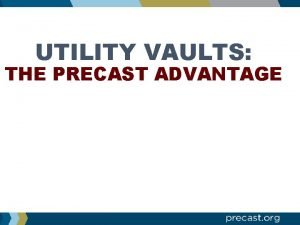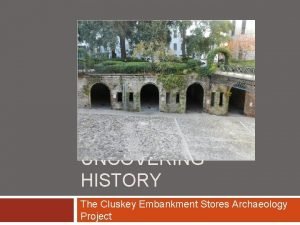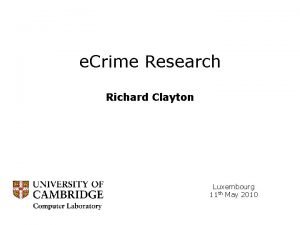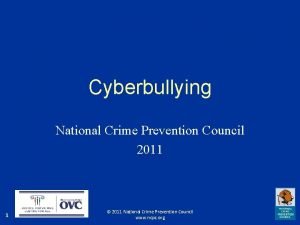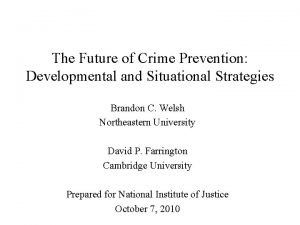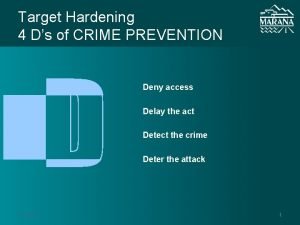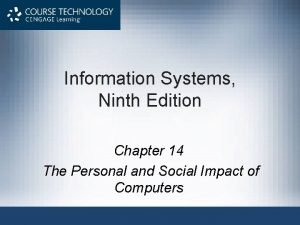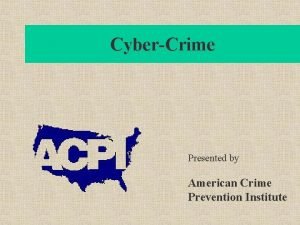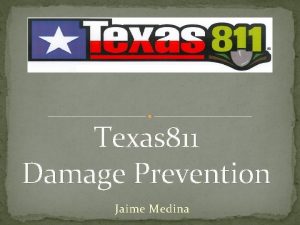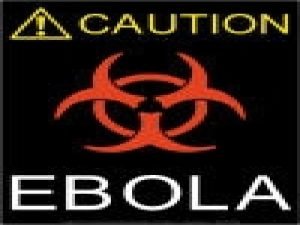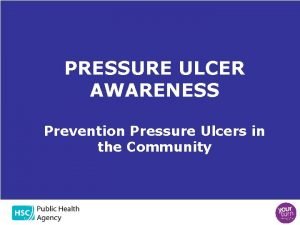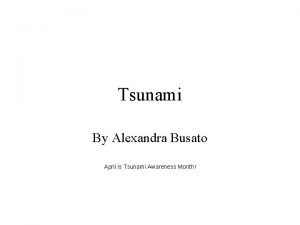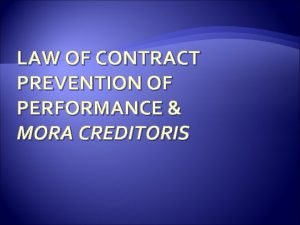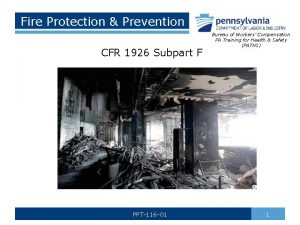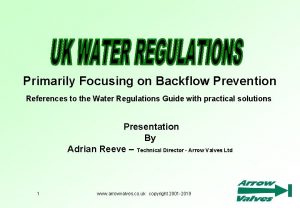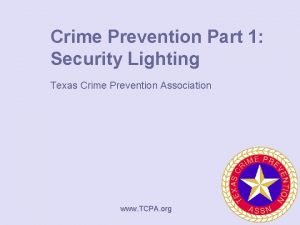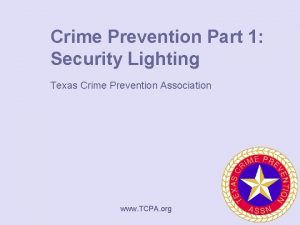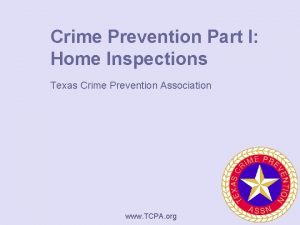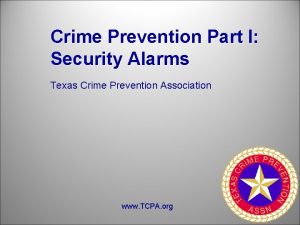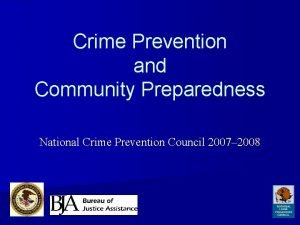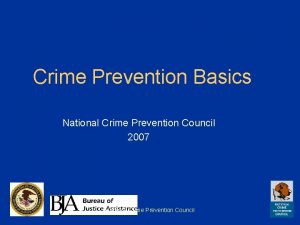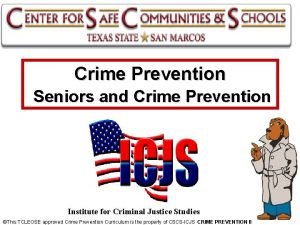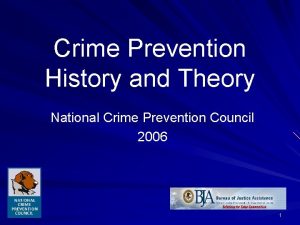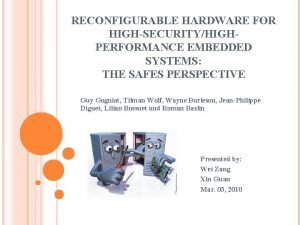Crime Prevention Part I Safes Vaults Texas Crime












































- Slides: 44

Crime Prevention Part I: Safes & Vaults Texas Crime Prevention Association www. TCPA. org

Learning Objectives The student will be able to. . . Identify different types of safes and vaults. Identify and explain the proper use of a money and fire safe. Identify and explain the various classes of insulated record containers. Identify and explain the different type of safe locks.

Learning Objectives Identify and explain the various UL classifications of money and fire safes. Identify and explain the following areas that affect the security of safes and vaults: Location and installation Protecting the combination and usage in compliance with classification

Safes & Vaults A Safe or Vault ideally should be located in the most secure area of the residence.

Safes: General Safe makers cannot make safe bodies as thick as they would like Ø Ø Ø Too big to pass through doorways Too heavy to stand on the floor of ordinary buildings Safes made at a cost which the customer will accept

Safes: Introduction Two Types of Safes Each is intended for a different purpose Type 1: Fire Safe n Designed to protect records from destruction by fire. Type 2: Money Safe or Money Chest n Designed to protect money and valuables from burglary or theft.

Safes: Confusion exists over the use of the two types of safes. n n Many users believe they have more protection than they actually do and unknowingly submit their valuables to risk. Because of this common misunderstanding, know how to use a safe for the purpose for which it is designed.

Fire Safe Records Safe Ø Ø Fire resistant qualities Provides only minimal protection from burglary and theft Constructed of light steel Manufacturer more concerned with insulation of the safe against fire vs. burglary defense

Fire Safe Fire resistant safes normally made with hollow walls of relatively thin steel, Filled with varying amounts of insulation. Easily broken open with a burglar’s heavy tool or with a firefighter’s axe. Do not store cash or valuables that are easily converted to cash.

Fire Safe Store important papers in a fire safe n Tax records – CD or DVD n Booking logs - ledgers n Insurance polices

Fire Safe The type & amount of insulation used in a fire safe determines the degree of protection afforded its contents. Example, paper products destroy when exposed to temperatures in excess of 350° F. Designed to keep interiors below critical 350° F level.

Fire Safe: Purpose The purpose of the fire safe is to ensure that after a fire its contents are “useable. ” The concept of “useable” documents is important. Ø A document is considered usable only if “…after a fire it can withstand ordinary handling without breaking and if marks on the paper can be deciphered by ordinary means. ”

Fire Safe: Purpose The concept of “useable” documents is important. A document is considered usable only if “…after a fire it can withstand ordinary handling without breaking and if marks on the paper can be deciphered by ordinary means”

Underwriters Laboratories A standardized fire of controlled extent and severity. . . n At least four hours (reaching 2000° F) n Two hours (reaching 1850°F)

Underwriters Laboratories One hour (reaching 1700°F) depending upon its hourly rating, before the interior temperature of the compartment exceeds the rated class temperature (350°F, 150°F, or l 25°F) during the period of fire exposure and the cooling period inside the furnace after the fire exposure.

Underwriters Laboratories Sudden Heating Ø At 2000°F for 30 minutes without producing an explosion is sufficient to cause an opening into the interior.

Underwriters Laboratories Impact due to falling 30 feet ØIn the clear after being heated for 60, 45, or 30 minutes for devices rated 4, 2, and 1 hour respectively Ø. . . and reheating in the inverted position for the same length of time (60, 45, or 30 minutes) after the impact without destroying the usability of the papers stored inside.

Fire Safe: Design Another important fire safe characteristic is its “reusability. ” A second-hand” fire safe does not provide good fire protection. Fire safes often make use of inflating materials that consist of gypsum, plaster, or other hydrous compounds. When exposed to fire, this inflating material is converted to steam which cuts down the destructive qualities of the fire

Combustible Material Paper may be destroyed if exposed to temperatures above 350°F. Films and videos are heat-sensitive and may be destroyed if exposed to temperatures above 150°F. Computer disks are the most sensitive to heat and may be destroyed if exposed to temperatures above 125°F.

Class 350 Fire Safe Protects Ø Ø Disks Microfilm (microfiche) Film Rolls Video

Classification Markings Look for classification markings on products Insulated record containers classified by: n Underwriter Laboratories, Inc. ØFire resistance only ØRating: Class 125 -2

Money Safe The key feature of a money safe is its resistance to burglary or robbery. Burglary restrictive safes are designed to withstand attacks by tools, torch, or explosives in proportion to their construction specifications. Robbery restrictive equipment is designed to prevent thefts when there is no assault on the money safe itself. (time delay safes)

Money Safe Categories Ø Key locks, lockers, and truck boxes with either key or combination locks Lighter Construction with less costly locking equipment

Money Safe Most money safes have undergone stringent testing at the Underwriters Laboratories, Inc. in Northbrook, Illinois. The Underwriters Laboratories, Inc. label indicates the classification of a safe and its capabilities

Burglar Resistant Key feature: Resists burglary and robbery Can only provide protection against the tools and techniques known at the time of construction. Design to withstand attacks by Ø Ø Ø Tools Torch Explosives All in proportion to construction specifications

Safe Locks Locking dials Lockable handles Time Locks Time delay combination Alarm combination

Safe Locks Locking Handles Ø Ø Lockable bolt control handles perform same function as lockable dials Allows the combination to be dialed; however, bolt control handle does not retract the door bolts until unlocked Time Locks Ø Ø Standard equipment on bank vault doors Ensures that once closed and locked, the safe or vault door remains for a predetermined amount of time

Safe Locks Time-Delay Locks n n n DAT or delayed action timer. Combination lock with one or more timer movements attached. Operator must wait for predetermined period after dialing before delay mechanism permits the combination bolt to retract.

Safe Locks Alarmed Combination Locks n n Incorporate micro-switches capable of shunting alarms and signalizing unauthorized opening attempts or openings made under duress Dial set at predetermined number and sometimes locked in place. Alarm is then turned on.

Safe Vulnerabilities Drills n diamond core Torches n n acetylene burning bar or thematic lance Øhollow iron pipe packed with steel rods Ø 4000 F Ø 6” of tempered steel Ø 15 sec

Safe Vulnerabilities Keri coil Ø Ø miniature version of burning bar underwater cutting

Security Recommendations: Precautions and Reminders Must be an extremely hard to blunt drills and heat absorbent to combat thermal cutter Concrete Ø Often strengthened by granite chips or by a chilled iron shot, which can spin or deny the drill.

Security Recommendations: Precautions and Reminders All top quality safes combat the drill with nuggets of a material almost as hard a diamond, closely packed with no clear path through them cutter Safes should be fixed (non-moveable) either encased in concrete or bolted to a solid foundation and/or frame

Security Recommendations: Precautions and Reminders Foiling the cutters Best defense are metals that absorb the heat at the point of attack and dissipate it over a wide area Steels with high chromium or carbon content, notably stainless steel and cast iron Copper, second most effective

Security Recommendations: Precautions and Reminders Lock Attack Best defense are live devices backed up by dead devices, which also secure the bolt frame but operate only if the lock is attached. Dead devices are bolts held back by cables running to the lock case and operate only if the cable connection is broken. In high quality safes, cables are connected to a glass plate which disintegrates if punctured.

Security Recommendations: Safe Combinations Important for safe security: Protecting the combinations Ø Ø Ø Protection is frequently overlooked Burglars find the combination Written and left inside the desk of a nearby secretary or executive Always memorize combination Keep emergency copy of the combination available in a locked area

Safe: Security Checklist Secure lightweight safes to prevent removal Keep cash on hand at a minimum by frequently banking Never leave combination where it can be compromised

Safe: Security Checklist Locate the safe in a secure area, and check to determine that the safe is proper for what is protects Lock the safe securely when leaving the premises by turning the dial several times in the same direction

Remember A safe can provide adequate protection only when it is used for its intended purpose.

Questions

Define and Process Identify the different types of safes and vaults. Identify and explain the proper use of a money and fire safe. Identify and explain the various classes of insulated record containers.

Define and Process Identify and explain the different type of safe locks. Identify and explain the various UL classifications of money and fire safes. Identify and explain the following areas that affect the security of safes and vaults; location and installation, protecting the combination and usage in compliance with classification

Sources Fennelly, Lawrence J. Handbook of Loss Prevention and Crime Prevention. Newton, MA. , Butterworth-Heinemann, 251. Healy, Richard J. Design for Security. New York: John Wiley and Sons, Inc. , 176 -178, 189 -190, 194 -199. Hemphill, Charles F. Jr. Security for Businesses and Industry. Homewood, Illinois: Dow Jones-Irwin, Inc. , 181, -194, 219 -221. Information Material by “AMSEC”. Paramount, California: American Security Products Company. Information Material by “Gary”. Industry, California: Gary Safe Company. Underwriters Laboratories, Inc. Building Materials Directory. 301 -304.

Contact Information www. TCPA. org
 Primary prevention secondary prevention tertiary prevention
Primary prevention secondary prevention tertiary prevention Gary safes
Gary safes Barrel vault romanesque
Barrel vault romanesque Precast concrete utility vaults
Precast concrete utility vaults Uncovering history first
Uncovering history first Youth crime prevention desk
Youth crime prevention desk Cyber crime prevention luxembourg
Cyber crime prevention luxembourg National crime prevention council cyberbullying
National crime prevention council cyberbullying Developmental crime prevention
Developmental crime prevention 4 d's of crime prevention
4 d's of crime prevention Situational crime prevention definition
Situational crime prevention definition 25 situational crime prevention techniques
25 situational crime prevention techniques Crimegis
Crimegis Ron clarke 1992
Ron clarke 1992 Crime prevention 9th edition
Crime prevention 9th edition Malaysia crime prevention foundation
Malaysia crime prevention foundation American crime prevention institute
American crime prevention institute Texas suicide prevention symposium
Texas suicide prevention symposium Tx 811 portal
Tx 811 portal Intermediate crime scene investigation texas
Intermediate crime scene investigation texas East texas piney woods weathering
East texas piney woods weathering Part part whole
Part part whole Part to part variation
Part to part variation Technical description
Technical description Part part whole addition
Part part whole addition Footed wares example
Footed wares example Unit ratio definition
Unit ratio definition The part of a shadow surrounding the darkest part
The part of a shadow surrounding the darkest part Secondary prevention
Secondary prevention Kansas eviction prevention program 2021
Kansas eviction prevention program 2021 Prevention and control of poliomyelitis
Prevention and control of poliomyelitis Fall prevention quiz for nurses
Fall prevention quiz for nurses Primary prevention of poliomyelitis
Primary prevention of poliomyelitis School crisis prevention and intervention
School crisis prevention and intervention Primordial prevention
Primordial prevention Ebola prevention
Ebola prevention Prevention
Prevention Prevention of tsunami
Prevention of tsunami Prevention of performance
Prevention of performance Sexual abuse awareness training quiz answers
Sexual abuse awareness training quiz answers Building fire protection ppt
Building fire protection ppt Fluid category 5 backflow prevention
Fluid category 5 backflow prevention Atlas injury prevention
Atlas injury prevention Prévention du suicide
Prévention du suicide Prevention of typhoid fever ppt
Prevention of typhoid fever ppt



